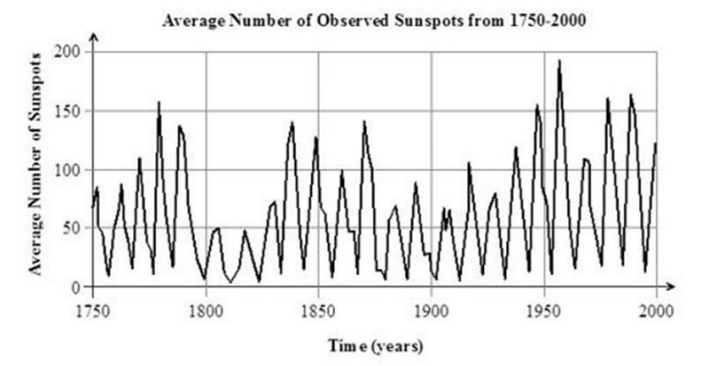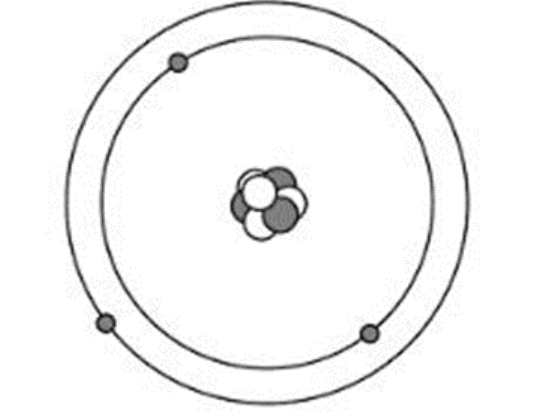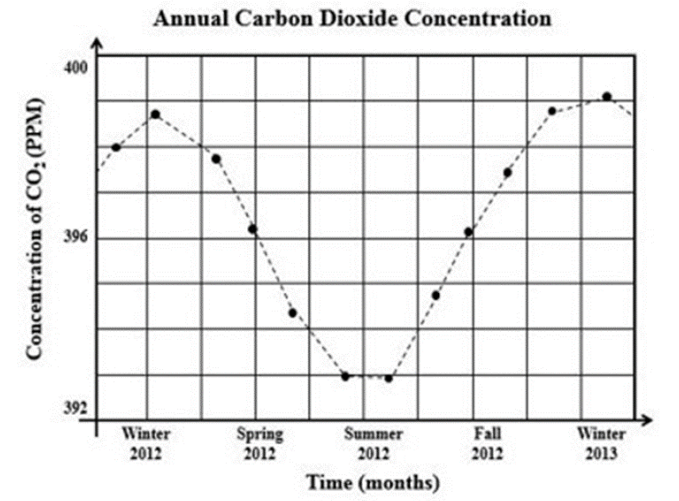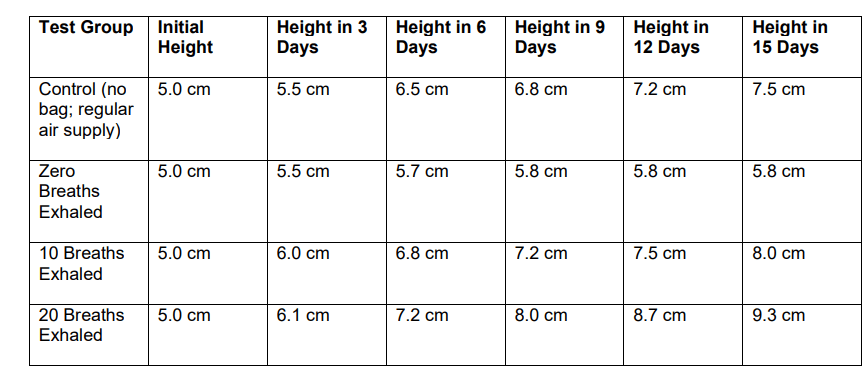Chris investigates the conservation of mass during a chemical reaction. He measures the mass of the reactants before the reaction, and the mass of the products afterward. He repeats his procedure ten more times and then shares his results with Garrett. Garrett says that the experiment was not valid. Which of the following would be the best way to replicate Chris's results from his experiment? (SC.8.N.1.2)
A. Ask Garrett to perform the experiment, but use different compounds for the reaction so the experiment will proceed faster.
B. Have Garrett perform the same experiment to see if he gathers similar data and results.
C. Chris repeats the experiment one more time in front of Garrett to confirm his results.
D. Repeat the experiment with a different mass to make sure that the law of conservation of mass is observed.
B. Have Garrett perform the same experiment to see if he gathers similar data and results.
Elizabeth mixes two chemicals together and measures the amount of thermal energy they release as they react. In this experiment, what is the amount of thermal energy released? (SC.8.N.1.1)
A. a constant
B. a controlled variable
C. a test variable (independent variable) variable
D. an outcome variable (dependent variable) variable
D. an outcome variable (dependent variable) variable
3. Amy's science teacher shows her class a model of an atom. Which of the following would be a benefit of using an atomic model? (SC.7.N.3.2)
A. All atoms exist in the gas phase and atmospheric gases are invisible.
B. All atoms exist in the liquid phase and are difficult to keep still
C. The parts of an atom are too small to be directly observed.
D. A model of an atom is the same for all elements.
C. The parts of an atom are too small to be directly observed.
1. Which statement best describes the nature of scientific theories? (SC.8.N.3.2)
A. Scientific theories are unchanging.
B. Scientific theories are frequently discarded.
C. Scientific theories can change with new evidence.
D. Scientific theories can become laws with further evidence.
C. Scientific theories can change with new evidence.
A hundred years ago, observations seemed to indicate an idea that the atom was a round solid sphere. Throughout history, experiments were conducted that resulted in observations that disproved this idea. This led to the present-day idea that the atom is composed of subatomic particles. Which statement best describes what this change in ideas tells us about science? (SC.8.N.2.2)
A. Science ideas do not need to be based on factual and observable evidence.
B. Science knowledge changes because it is open to new evidence as it is discovered and observed.
C. Science ideas are not accurate because they constantly change as new evidence is discovered.
D. Science is based on factual observations so it should remain the same and not change over time.
B. Science knowledge changes because it is open to new evidence as it is discovered and observed.
To test the effectiveness of a new cancer medication, scientists at a pharmaceutical company conducted a clinical trial. They administered the medication to a woman with a cancerous tumor and monitored the tumor for changes. Because the tumor became smaller, the scientists concluded that the medication worked. Which of the following best describes whether the company should publish the results and market this new medication? (SC.8.N.1.2)
A. Yes they should, because the woman’s tumor became smaller. This medication should be marketed based on this information.
B. No they should not, because there are too many drugs on the market right now. There should be a waiting period before the medication is available to consumers.
C. Yes they should, because it might be a long time before another drug shows as much promise. Scientists need to release this new medication as soon as possible.
D. No they should not, because only one person participated in this experiment. More trials need to be conducted to ensure that it truly was the medication that caused the change.
D. No they should not, because only one person participated in this experiment. More trials need to be conducted to ensure that it truly was the medication that caused the change.
Helen is studying the growth of different types of plants. She planted two of each type of plant in locations with different levels of sunlight: full sun, partial shade, and full shade. For five weeks, Helen records growth by counting the number of new leaves on each plant. Which of the following statements correctly describes the test variable (independent variable) and outcome variable (dependent variable) in Helen's experiment? (SC.8.N.1.1)
A. The test variable (independent variable) is the kind of plant, and the outcome variable (dependent variable) is the amount of sunlight.
B. The test variable (independent variable) is the amount of sunlight, and the outcome variable (dependent variable) is the kind of plant.
C. The test variable (independent variable) is the amount of sunlight, and the outcome variable (dependent variable) is the number of new leaves.
D. The test variable (independent variable) is the number of new leaves, and the outcome variable (dependent variable) is the amount of sunlight.
C. The test variable (independent variable) is the amount of sunlight, and the outcome variable (dependent variable) is the number of new leaves.
A group of students hypothesize that warmer water will always dissolve greater amounts of a substance. The table below shows the results of their investigation.

Which of the substances does NOT support the group’s hypothesis? (SC.8.N.1.1)
A. Substance W B. Substance X C. Substance Y D. Substance Z
C. Substance Y
2. What is most often the next step if scientific evidence is established that does not support an accepted theory? (SC.8.N.3.2)
A. The theory is discarded
B. The theory is accepted anyway.
C. The theory is developed into a law.
D. The theory is modified with new information.
D. The theory is modified with new information.
John is conducting an experiment that involves melting ice cubes. Which of the following is most important for John to collect reliable data? (SC.8.N.1.1)
A. Only one variable should be tested during the experiment.
B. Technology needs to be used to determine the results.
C. An unbiased observer must witness the experiment.
D. The outcome needs to be controlled.
A. Only one variable should be tested during the experiment.
The following statements were taken from the procedures of four different investigations.
INVESTIGATION PROCEDURES
1. To make a mixture, stir together the following five substances in a beaker: salt, pepper, glass beads, iron filings, and water.
2. Tear the paper strip into five pieces of about the same size.
3. Conduct five trials, measuring and comparing the total mass of the substances before and after the chemical reaction occurs.
4. In each of the two beakers, dissolve 10 grams (g) of sugar in 200 millimeters (mL) of water.
The statement from which investigation is an example of repetition? (SC.8.N.1.2)
A. 1 B. 2 C. 3 D. 4
C. 3
A student performs an investigation and titles her report: Does the Amount of Rain Affect the Clarity of Well Water? What is the test variable (independent variable) in this investigation? (SC.8.N.1.1)
A. the well
B. the date of rainfall
C. the amount of rainfall
D. the clarity of the well water
C. the amount of rainfall
Astronomers have been recording the number of sunspots they observe on the Sun for several hundred years. The graph below shows some of the data for sunspot activity over a period 250 years.

Which of the following statements is best supported based on the data above? (SC.8.N.3.1)
A. Sunspot activity was the highest in 1800.
B. Sunspots only started to occur after the year 1750.
C. Sunspot activity will start to decrease sometime after the year 2000.
D. Sunspot activity will cause the rotation of the Sun to increase every year.
C. Sunspot activity will start to decrease sometime after the year 2000.
Which statement best summarizes the development of the atomic theory over time? (SC.8.N.3.2)
A. The discovery of new evidence resulted in changes to the atomic theory.
B. Advancements in atomic models proved the atomic theory was accurate.
C. The atomic theory was modified with the discovery of every new element.
D. Changes in atomic models showed the atomic theory was based on opinion.
A. The discovery of new evidence resulted in changes to the atomic theory.
A student investigates the effects of five brands of fertilizer on plant growth and concludes that Brand X works best. Which of the following would best communicate this conclusion? (SC.8.N.1.1)
A. a list of the ingredients in each brand of fertilizer used
B. a diagram showing the conditions in which each plant grew
C. a description of the role of different nutrients in plant growth
D. a graph showing the growth rate of plants grown with the different fertilizers
D. a graph showing the growth rate of plants grown with the different fertilizers
Eden is measuring the pH of various liquids to see if they are acids or bases. Although she is following the same procedure each time, she notices that when she tests a particular liquid, she obtains a result she does not expect. She is not sure that the result is accurate. Which of the following best describes what Eden should do to improve the reliability of the data she collects? (SC.8.N.1.2)
A. change her hypothesis
B. perform repeated trials on each liquid
C. measure a smaller volume of each sample
D. research more information about acids and bases
B. perform repeated trials on each liquid
A student wanted to see if the color of water impacted the increase in temperature, in degrees Celsius, after 30 minutes in the Sun. Three beakers were filled with 50 milliliters of water, and five drops of food coloring were added to each beaker. The beakers were then placed on a window ledge in direct sunlight and temperature readings were recorded every 10 minutes for 30 minutes.

What was the test variable (independent variable) in this experiment? (SC.8.N.1.1)
A. the color of the water
B. the temperature of the water
C. the amount of water in each beaker
D. the amount of time each beaker was exposed to sunlight
A. the color of the water
Alex is building a model of the solar system as a classroom science project. The purpose of the model is to compare the properties of the planets within our solar system. Which model is the best option for Alex's project? (SC.8.N.3.1)
A. a Power Point explaining the planets' histories and how ancient astronomers named them
B. a class model on the football field that shows each planet's relative size, temperature range, surface features, and chemical composition
C. a 3-D model of the solar system that shows each planet's relative size, temperature range, surface features, and chemical composition
D. a computer model showing how scientists have used scientific laws and theories to support the theories of planet formation within our solar system
C. a 3-D model of the solar system that shows each planet's relative size, temperature range, surface features, and chemical composition
5. Niels Bohr proposed a model of the atom in 1913. This model has been widely accepted and is still used in many chemistry classrooms. An example of the Bohr model is on the image below.

While Bohr's model has many benefits, which of the following is considered a limitation of Bohr's model? (SC.7.N.3.2)
A. It does NOT show subatomic particles within the atom.
B. It does NOT show the general location of the nucleus within the atom.
C. It does NOT show how the subatomic particles within the atom move and interact.
D. It does NOT show details of the atom that would be impossible to see without a microscope.
C. It does NOT show how the subatomic particles within the atom move and interact.
A science class plans to examine the densities of five different materials. Each student will calculate the density by recording the mass and volume of each of the five materials. They plan to share their individual results to calculate a class average for the density of each material. Which of the following actions would best help the students calculate the class average? (SC.8.N.1.1)
A. Each student should design his or her own experiment.
B. Each student should follow the same procedure.
C. Each student should make an individual hypothesis.
D. Each student should measure only one material.
B. Each student should follow the same procedure.
Chris investigates the conservation of mass during a chemical reaction. He measures the mass of the reactants before the reaction, and the mass of the products afterward. He repeats his procedure ten more times and then shares his results with Garrett. Garrett says that the experiment was not valid. Which of the following would be the best way to replicate Chris's results from his experiment? (SC.8.N.1.2)
A. Ask Garrett to perform the experiment, but use different compounds for the reaction so the experiment will proceed faster.
B. Have Garrett perform the same experiment to see if he gathers similar data and results.
C. Chris repeats the experiment one more time in front of Garrett to confirm his results.
D. Repeat the experiment with a different mass to make sure that the law of conservation of mass is observed.
B. Have Garrett perform the same experiment to see if he gathers similar data and results.
Helen is studying the growth of two different types of plants. She planted two of each type of plant in locations with different levels of sunlight: full sun, partial shade, and full shade. For five weeks, Helen records the number of new leaves on each plant. Which of the following statements correctly describes the independent and dependent variables in Helen's experiment? (SC.8.N.1.1)
A. The independent variable is the amount of sunlight, and the dependent variable is the number of new leaves.
B. The independent variable is the kind of plant, and the dependent variable is the amount of sunlight.
C. The independent variable is the amount of sunlight, and the dependent variable is the kind of plant.
D. The independent variable is the number of new leaves, and the dependent variable is the amount of sunlight
A. The independent variable is the amount of sunlight, and the dependent variable is the number of new leaves.
Which of the following best represents the amount of carbon dioxide (CO2) in the atmosphere during the summer of 2012? (SC.8.N.1.1)

A. 390 PPM B. 393 PPM C. 396 PPM D. 399 PPM
B. 393 PPM
Lin's science fair project is on the effects of carbon dioxide levels on plant growth. Lin's hypothesis is "if more carbon dioxide is present, then the plant will grow faster." Each test plant is placed in a clear container, and Lin exhales different amounts of carbon dioxide into the containers. She collects data every 3 days for 2 weeks and records it in a data chart, as shown below.

Based on the data from Lin's experiment, which Test Group data supports her hypothesis? (SC.8.N.1.1)
A. Control (no bag; regular air supply)
B. Zero Breaths Exhaled
C. 10 Breaths Exhaled
D. 20 Breaths Exhaled
D. 20 Breaths Exhaled
Jason is investigating the densities of different liquids. He pours 50 mL of water into a large graduated cylinder. He then repeats this process by pouring 50 mL of rubbing alcohol and dish soap in the same graduated cylinder. Which statement below will allow Jason to draw a conclusion regarding the densities of the different liquids? (SC.8.N.1.1)
A. the color of each liquid after all the liquids are settled
B. the position of each liquid after all the liquids are settled
C. the volume of each liquid before and after all the liquids are settled
D. the temperature of the liquids before and after all the liquids are settled
B. the position of each liquid after all the liquids are settled